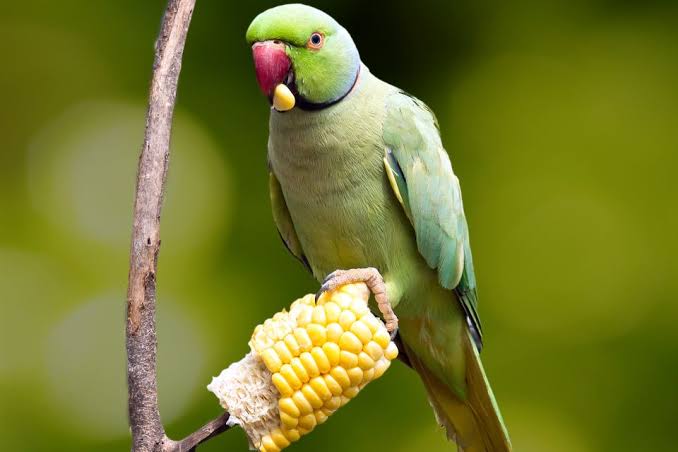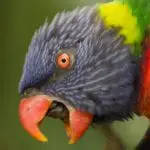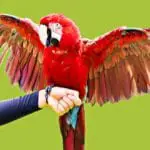Parrots are just like other animals; these also suffer from nutritional problems like malnutrition. Malnutrition is a word to describe poor nutrition. This could be from an excessive or insufficient diet or a diet that has unbalanced nutrition due to an individual’s inability to take in food.
Pet parrots or captive parrots are more at risk for developing nutritional problems than wild parrots. This is due to these bird’s ability to find food on their own; they can look for nutritious food easily. Birds like parrots forage for food in large, noisy groups, and usually, when they have eaten all the food in the area, they would proceed to another nearby land where they can have their fill.
Meanwhile, captive birds merely rely on their owner’s time and patience to feed them. If they don’t receive food or are provided with incorrect food, they may end up suffering from nutritional conditions, especially malnutrition.
Wild parrots also have a varied diet consisting of almost all plant parts from seeds to flowers, fruits to nuts; they will eat anything that they find delicious. And because of this variety, they can take in different nutrients that they need to keep them healthy.
How to tell if your pet parrot is malnourished?
If you have a pet parrot, it’s crucial to provide it the best nutrients from the food it eats. It’s also vital for pet owners to identify early signs of nutrient problems, especially if their pet is malnourished. Here are signs that you should watch out:
Dull, discolored feathers
The very first thing that you’ll notice in a malnourished parrot is the condition of its plumage. If your parrot has colorful, bright, and showy primary and tail feathers and suddenly, you notice these become dull, discolored, and are starting to change in texture; then, these may be due to a nutritional deficit or malnutrition.
This sign is one of the most common in almost all birds, not just parrots. Usually, this serves as an early warning sign and a sign that you must act right away. This symptom is also a way to tell if your bird is starting to get well. You will see that it has started to regain its feathers’ true colors, shine, and health.
Brittle tail and primary feathers
A malnourished bird will have weak feathers which may easily separate from the bird’s body and may also break. Pick one fallen feather, and you’ll notice that the once previous smooth and perfect form is now clumped, wiry, and very brittle.
When you spot a bird with brittle, falling, and uneven tail and primary feathers, the condition of the bird has already turned for the worse. You must also consider other parrot health issues other than malnutrition. Psittacosis or parrot fever is an infection or a disease that is due to a microbe called Chlamydia psittaci. This is a highly communicable disease among birds and can be transferred to humans. Parrots suffering from this disease can develop brittle and fluffed feathers, lethargy, nasal discharge, enlarged liver, diarrhea, and weight loss. Usually, parrot disease is fatal, especially when a bird is already malnourished.
To rule out parrot fever, consult your pet’s veterinarian. Tests will be done to find out if your pet’s brittle feathers are due to malnutrition or due to psittacosis.
Beak and toenail problems

The most commonly affected parts of birds are their beaks and nails. If you see overgrown toenails and beaks or flakiness on the beaks and toes, then these could be due to malnutrition. If you can touch your pet, feel its beak and toes.
Any soft part or protruded part may be due to a health condition. The beak and nails in a healthy bird are hard, well-formed, and smooth. There should be no soft parts or bumpy parts as much as any area that may feel swollen or inflamed. Touching these parts must not hurt your pet.
If you spot flaking or overgrown nails and beak in your pet parrot, then it’s health condition or malnutrition may have already turned for the worse. Your pet needs immediate medical attention.
Too many health issues
If your vet visits are more frequent because of different health issues, then your pet may have not recovered from its previous illnesses. Poor recovery can lead to complications and may also cause a lack of appetite and, eventually, malnutrition.
If your pet has this symptom, it’s important to treat any underlying medical issue before proceeding with changing its diet. It’s a must to improve its diet as soon as it has completely recovered. Your pet’s vet can help, or you may seek help from a dietician.
Respiratory issues
Malnourished parrots and other birds suffer from many health issues, including respiratory problems. The most common issues are sneezing with discharge from the nose, dry and crusted areas of the nose or beak, and your bird is acting as if it wants to vomit something.
Usually, having respiratory issues or respiratory conditions that do not seem to go away, can be due to worse nutritional problems. To deal with this symptom, treatment of the underlying respiratory issue is coupled with changing your pet’s diet to a healthy and well-rounded diet.
Eye problems

Malnourished parrots suffer from eye problems like discharge and swelling around or above the eyes. These symptoms can be due to a respiratory problem after being deficient from the necessary nutrients parrots need.
As with other symptoms mentioned in our list, a vet will rule out other health conditions like respiratory illnesses, which can also cause eye swelling and discharges. Treatment and providing the ideal diet fit for your pet’s needs will be recommended.
Being overweight or underweight
Make it a habit to weigh your pet. Use a small weighing scale as a food scale for small parrots and a regular weighing scale for bigger ones. Weigh your pet at least once a week to check for any health issues, nutritional problems, etc.
If you notice that your pet is losing weight or gaining weight in a very unusual manner, then you must not overlook these signs. Most of the time, bird pet owners are not really up to weighing their pets but just manage to do this once they visit the vet. If this is, so then you might not be able to find out your pet’s condition early.
Just like humans and other pet animals like dogs and cats, you can tell by checking on the bird’s appearance that it has lost or gained weight. Weight loss signs are sunken or protruding eyes or eyeballs, beaks looking bigger or the head looking smaller and the body looking smaller or bigger. It’s hard to tell how a bird looks like from all its feathers. What you can do is hold your pet in your hand and feel its body. A healthy bird will have a body with good form while a malnourished pet may have a bony body or a fat/overweight one.
It’s best to weigh your pet regularly, whether it’s healthy or not. This is just a way to get baseline data of your pet’s health so you can refer to it in case of any health issue.
Problems with stool or urine
Another sign that your pet is suffering from malnutrition is the condition of its stool and urine. You, as it’s caretaker, must know what your pet’s stool looks like and the color of its urine as well. If you find any changes like the stool turning brown to green or from a semi-solid shape to a watery mess, then you must suspect a health condition.
Smelly stools and urine can also indicate problems with your pet’s condition. And if your pet is not pooping or urinating at all, then this could be a serious sign. Impaction of the gastrointestinal system and kidney problems are also common in birds, and if your pet has this sign, you should take it to the vet at once.
The vet will likely take measures to control diarrhea or constipation. The goal is to preserve your parrot’s health and to improve its diet better. Your pet may need an electrolyte solution to help prevent malnutrition.
Behavioral problems/changes
Birds are like people as they can be nippy and irritable when sick. A bird that’s malnourished may display moodiness behaviors like plucking or picking its feathers, nipping or biting, settling on one area of the cage, or sleeping for longer hours.
If you’re used to a well-behaved pet or a bird that’s pleasant, happy, and gentle, these behaviors may surprise you. Consider that some illnesses can also cause behavioral changes in your pets. Therefore, you should take your pet to the vet as soon as you notice these symptoms so the doctor can rule out other conditions and for immediate treatment.
What to do with a malnourished pet parrot?

A malnourished pet parrot needs immediate care. It should be taken to a vet specifically to an avian vet and dietician to help improve its condition. To help your pet recover, you can also help by doing the following.
Change your pet’s diet
Most parrots that suffer from malnutrition are not getting enough nutrients from the food that they are eating. First-time parrot owners are guilty of feeding their pets with food that are not fit for them. For example, thinking that your pet parrot will only eat seeds is a common reason for health issues.
Treat seeds as junk food for birds; this food may be part of a wild bird’s diet, but it must not be its staple food. Also, feeding your parrot too much can cause malnutrition. A change in its diet can help. A parrot organic food is known as “Feed Your Flock” can help your pet improve its diet.
Organic pet food like FYF is healthy, natural, and won’t upset your pet’s digestion. It also has natural vitamins and minerals your pet parrot needs for optimum health. And a bonus for FYF customers is that their food is delivered to your door once a month, so you don’t need to go to a store to buy. FYF is not available in most pet stores and orders are usually done online. You even get a free recipe book since you can use this pellet food with other natural food items like fruits, vegetables, nuts, sprouts and more.
Reserve fatty foods as treats
Seeds and nuts are fatty foods and should only be a small part of your pet’s diet. Never spoil your pet with this food and use these only when training your pet. Use this to reward your pet for good behavior or when you’re teaching your pet parrot new tricks. Because parrots love seeds and nuts so much, they will likely look forward to training with you as well.
Add fresh and raw fruits and veggies
Aside from commercially-prepared pellet food for birds, include fresh and raw fruits and veggies. We recommend adding small pieces of fruits and veggies in their daily diet. Also, you can make a smoothie or dry some pieces of fruit to add variety to your pet’s daily meals.
At first, your pet may not welcome new food, especially when it is used to eating commercial pet food or seeds and nuts. To convince your pet that fresh food is better, feed fruits and veggies in the morning when it is likely to be very hungry. It will eat this food if there is nothing else to eat! If it accepts the new food, make sure that you provide this new kind of food daily.
Supplements can help
Your pet may feel better after receiving some important supplements. You can house your pet inside an outdoor aviary where it can get more sunlight, a source of vitamin D. This vitamin is important for feather health and for improving your pet’s behavior. Supplements may also be recommended by your doctor. Minerals like calcium are needed for bone, beak, and nail health.
Try Harrison’s Bird Food, a supplement available in most pet stores and from the vet’s offices. This brand makes different bird food and supplement formulas to enhance your pet’s nutrition and health. Harrison’s Bird Food is all-natural, organic, non-GMO-verified, and tasty too. Their red palm oil can help improve plumage health.
Plumage health
Plumage and nail health is a sign of a healthy and well-rounded pet parrot. As you slowly transform your diet, you also need to improve its plumage health, and you can do this by frequent bathing. You can try organic soaps and shampoos made for birds; these products are gentle and won’t irritate your pet’s already irritated skin.
Some parrot owners are more creative as they look for ways to make their pets more comfortable, like letting them wear knitted sweaters or placing them in a warm cage. These things will help pet parrots that have lost their feathers due to their health conditions.
A pet parrot can willingly accept new food if you patiently train it. Use the new food as treats. Make it more curious about new food by using it as decoration inside its cage. You can place a cooked ear of corn inside the cage to use as a perch. String up cubes of fruit and decorate its cage like a fiesta. You can cook different shapes of pasta and place these inside the cage by creating a necklace. Let your pet work for its food and not just idly standing and waiting for you to feed it. Finally, don’t hesitate to take your pet parrot to the vet to get immediate medical attention. Sure, parrots can talk, but it can’t tell you that it’s sick. It’s still your responsibility as its owner to understand the signs and symptoms that your pet needs your help.



